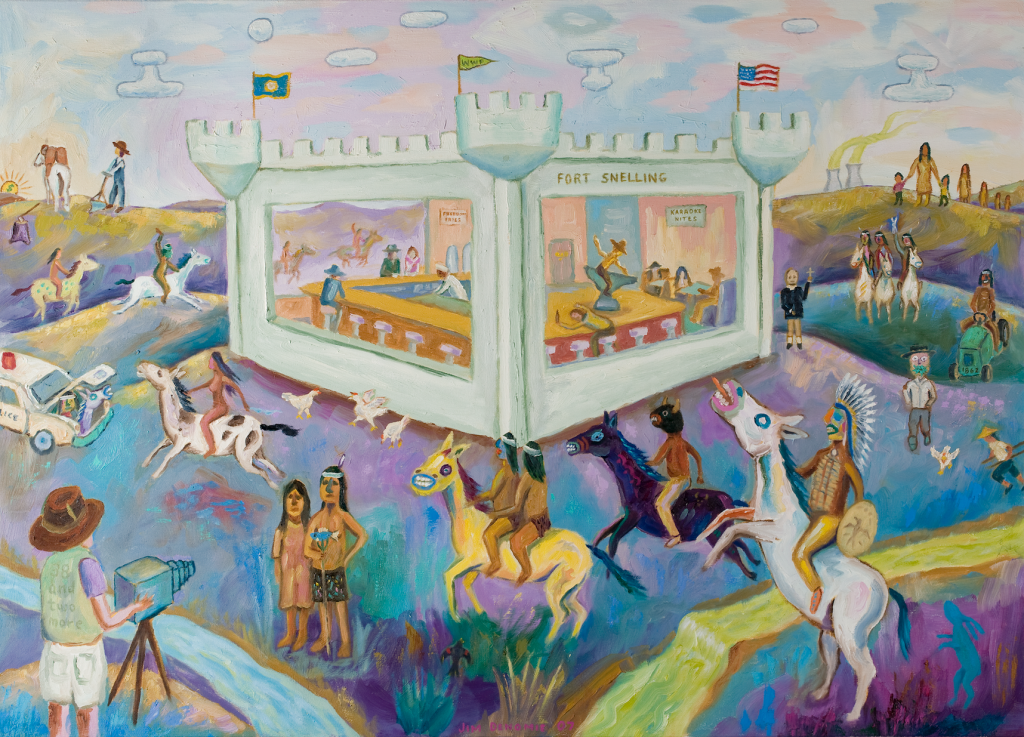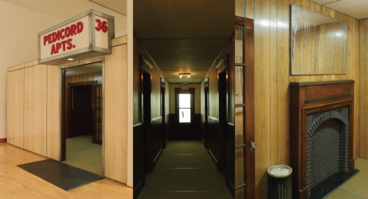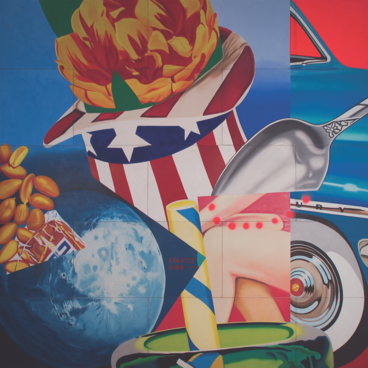In the scholarly field of art history, iconography is the practice of identifying and interpreting symbols, icons, and the content of imagery in a work of art. Jim Denomie describes his painting Attack on Fort Snelling Bar and Grill as “a visual story about some of the historical events concerning the state of Minnesota and the Ojibwe and Dakota tribes within its boundaries since the 1862 Dakota War.” A native of the Midwest and a member of the Lac Courte Oreilles Band of Ojibwe, Denomie paints stories from his own dreams and experiences, as well as historical events, including many that have been harmful and hurtful to the American Indian community. Often these scenes express sarcasm or anger at the attitudes developed during these events.
Attack on Fort Snelling Bar and Grill was one of Denomie’s first paintings after his year long project in 2005, during which he painted at least one painting every day of the year. Jim explains that, in many ways, this painting is a continuation of his earlier Renegade series, and indeed it repeats icons developed in his previous works. “It is still political, social, and historical commentary, but a different landscape and a much larger canvas,” he adds.
Many of the images in this piece represent real historical events that occurred in Minnesota and affected Native Americans since the 1862 US-Dakota War. There are thirty-eight figures in the painting, plus two rabbits, signifying the thirty-eight Dakota men who were hanged on December 26, 1862 in Mankato, plus two others who were captured and hanged three years later. Fort Snelling, depicted at the center of the image, served as an internment camp for imprisoned Dakota men, women, and children during the winter of 1862 and spring of 1863. It also housed the Indian Administration, a federal government agency that was implicated in the withholding of provisions that spurred the 1862 US-Dakota War.
In the upper left corner, an Indian on horseback is mooning Governor Tim Pawlenty, pictured as a farmer, while the sun rises beyond the hill. This scene satirizes the Minnesota state seal in which a white farmer is depicted working at sunrise, with an Indian on horseback in the background.
Further down the left side, a Native American and a horse are in the trunk of a police car. This refers to an incident in April 1993 when two Minneapolis officers were suspended for taking two intoxicated Native Americans to the hospital in the trunk of their car.
The photographer in the lower left of the painting references photographer Edward Curtis. At the turn of the twentieth century, Curtis produced a large series of photographs, The North American Indian, through which he sought to document traditional life of what he deemed a “vanishing race.” Today his photographs are controversial, and Curtis is often criticized for portraying Native Americans in popular stereotypes and removing objects of Western culture from his images. The Indian couple posing for the photographer in Denomie’s painting resembles the couple in the famous 1930 American Gothic portrait by the Iowa-born artist Grant Wood. American Gothic was seen as a depiction of authentic, rural American life during the Depression era, and the painting has since become one of the most popular and most parodied in American pop culture.
The wide-eyed farmer on the right side of the painting, running down the hill with a mouthful of grass, recalls a historically infamous meeting just before the start of the 1862 US-Dakota War. After a poor crop season, Indians were starving and the government betrayed its promise to provide the Dakota tribe with food. During a meeting between Indian chiefs and traders, the shop owner Andrew Myrick suggested to essentially let the Indians “eat grass.” War began soon after this meeting.
-Taken from the Fall 2012 Newsletter.



